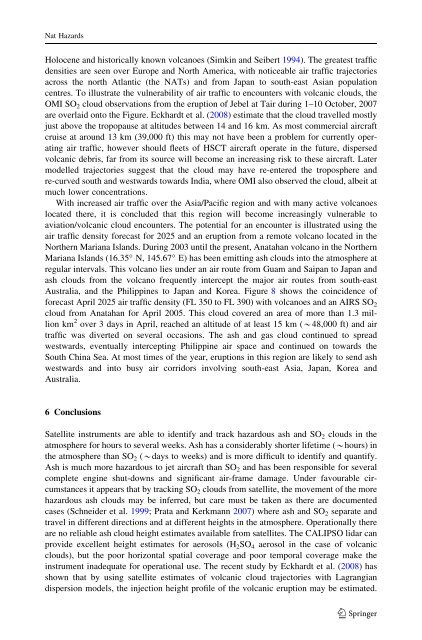Satellite detection of hazardous volcanic clouds and ... - Savaa - NILU
Satellite detection of hazardous volcanic clouds and ... - Savaa - NILU
Satellite detection of hazardous volcanic clouds and ... - Savaa - NILU
Create successful ePaper yourself
Turn your PDF publications into a flip-book with our unique Google optimized e-Paper software.
Nat HazardsHolocene <strong>and</strong> historically known volcanoes (Simkin <strong>and</strong> Seibert 1994). The greatest trafficdensities are seen over Europe <strong>and</strong> North America, with noticeable air traffic trajectoriesacross the north Atlantic (the NATs) <strong>and</strong> from Japan to south-east Asian populationcentres. To illustrate the vulnerability <strong>of</strong> air traffic to encounters with <strong>volcanic</strong> <strong>clouds</strong>, theOMI SO 2 cloud observations from the eruption <strong>of</strong> Jebel at Tair during 1–10 October, 2007are overlaid onto the Figure. Eckhardt et al. (2008) estimate that the cloud travelled mostlyjust above the tropopause at altitudes between 14 <strong>and</strong> 16 km. As most commercial aircraftcruise at around 13 km (39,000 ft) this may not have been a problem for currently operatingair traffic, however should fleets <strong>of</strong> HSCT aircraft operate in the future, dispersed<strong>volcanic</strong> debris, far from its source will become an increasing risk to these aircraft. Latermodelled trajectories suggest that the cloud may have re-entered the troposphere <strong>and</strong>re-curved south <strong>and</strong> westwards towards India, where OMI also observed the cloud, albeit atmuch lower concentrations.With increased air traffic over the Asia/Pacific region <strong>and</strong> with many active volcanoeslocated there, it is concluded that this region will become increasingly vulnerable toaviation/<strong>volcanic</strong> cloud encounters. The potential for an encounter is illustrated using theair traffic density forecast for 2025 <strong>and</strong> an eruption from a remote volcano located in theNorthern Mariana Isl<strong>and</strong>s. During 2003 until the present, Anatahan volcano in the NorthernMariana Isl<strong>and</strong>s (16.35° N, 145.67° E) has been emitting ash <strong>clouds</strong> into the atmosphere atregular intervals. This volcano lies under an air route from Guam <strong>and</strong> Saipan to Japan <strong>and</strong>ash <strong>clouds</strong> from the volcano frequently intercept the major air routes from south-eastAustralia, <strong>and</strong> the Philippines to Japan <strong>and</strong> Korea. Figure 8 shows the coincidence <strong>of</strong>forecast April 2025 air traffic density (FL 350 to FL 390) with volcanoes <strong>and</strong> an AIRS SO 2cloud from Anatahan for April 2005. This cloud covered an area <strong>of</strong> more than 1.3 millionkm 2 over 3 days in April, reached an altitude <strong>of</strong> at least 15 km (*48,000 ft) <strong>and</strong> airtraffic was diverted on several occasions. The ash <strong>and</strong> gas cloud continued to spreadwestwards, eventually intercepting Philippine air space <strong>and</strong> continued on towards theSouth China Sea. At most times <strong>of</strong> the year, eruptions in this region are likely to send ashwestwards <strong>and</strong> into busy air corridors involving south-east Asia, Japan, Korea <strong>and</strong>Australia.6 Conclusions<strong>Satellite</strong> instruments are able to identify <strong>and</strong> track <strong>hazardous</strong> ash <strong>and</strong> SO 2 <strong>clouds</strong> in theatmosphere for hours to several weeks. Ash has a considerably shorter lifetime (*hours) inthe atmosphere than SO 2 (*days to weeks) <strong>and</strong> is more difficult to identify <strong>and</strong> quantify.Ash is much more <strong>hazardous</strong> to jet aircraft than SO 2 <strong>and</strong> has been responsible for severalcomplete engine shut-downs <strong>and</strong> significant air-frame damage. Under favourable circumstancesit appears that by tracking SO 2 <strong>clouds</strong> from satellite, the movement <strong>of</strong> the more<strong>hazardous</strong> ash <strong>clouds</strong> may be inferred, but care must be taken as there are documentedcases (Schneider et al. 1999; Prata <strong>and</strong> Kerkmann 2007) where ash <strong>and</strong> SO 2 separate <strong>and</strong>travel in different directions <strong>and</strong> at different heights in the atmosphere. Operationally thereare no reliable ash cloud height estimates available from satellites. The CALIPSO lidar canprovide excellent height estimates for aerosols (H 2 SO 4 aerosol in the case <strong>of</strong> <strong>volcanic</strong><strong>clouds</strong>), but the poor horizontal spatial coverage <strong>and</strong> poor temporal coverage make theinstrument inadequate for operational use. The recent study by Eckhardt et al. (2008) hasshown that by using satellite estimates <strong>of</strong> <strong>volcanic</strong> cloud trajectories with Lagrangi<strong>and</strong>ispersion models, the injection height pr<strong>of</strong>ile <strong>of</strong> the <strong>volcanic</strong> eruption may be estimated.123
















